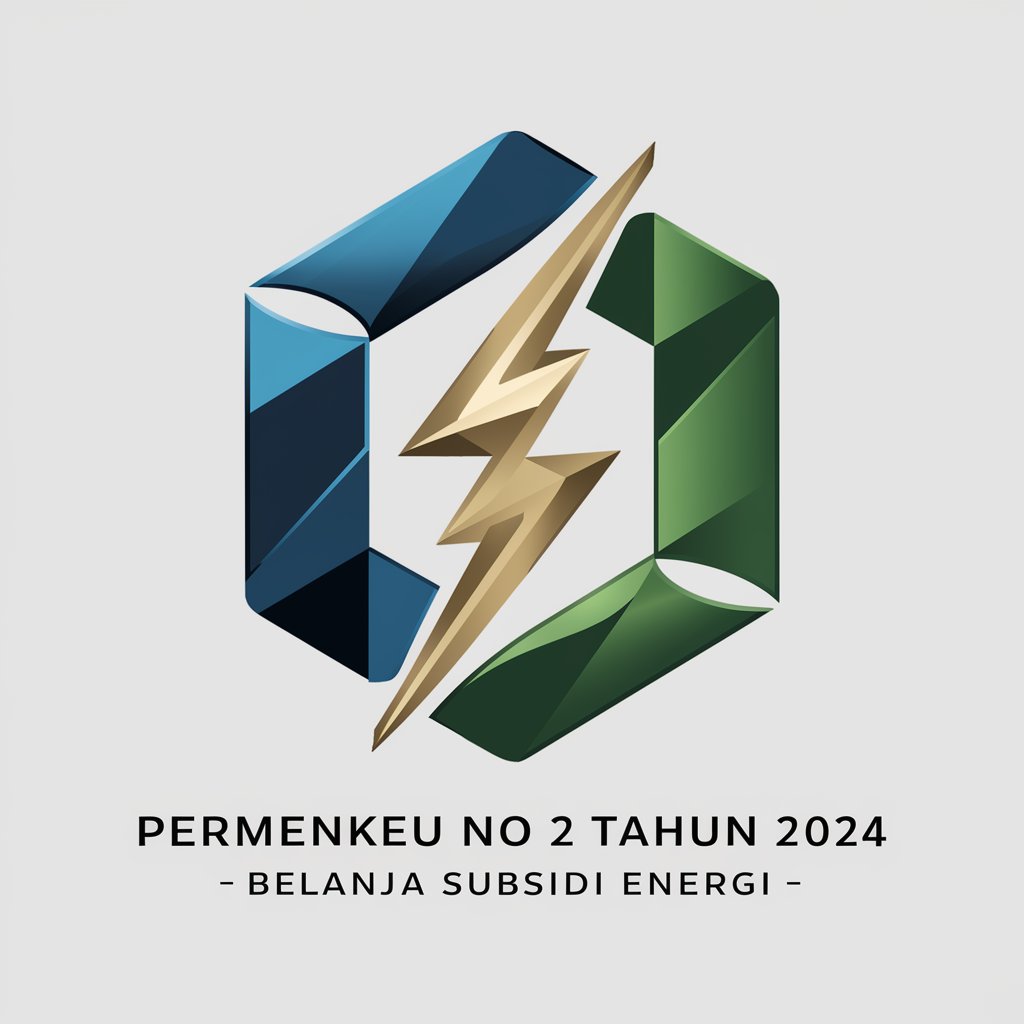Permenkeu no 2 tahun 2024 - belanja subsidi energi - Guide to Energy Subsidy Policy

Hello! How can I assist you with 'Permenkeu no 2 tahun 2024' today?
Navigate Energy Subsidies with AI
How does the regulation 'Permenkeu no 2 tahun 2024' impact energy subsidies?
What are the key features of 'Permenkeu no 2 tahun 2024'?
Can you explain the financial implications of 'Permenkeu no 2 tahun 2024'?
What are the benefits of energy subsidies under 'Permenkeu no 2 tahun 2024'?
Get Embed Code
Introduction to Permenkeu No. 2 Tahun 2024 - Belanja Subsidi Energi
Permenkeu No. 2 Tahun 2024 pertains to the regulations set by the Indonesian Ministry of Finance regarding the calculation methods for a specific percentage of the increase in energy subsidy expenditure and/or energy compensation charged against the increase in Non-Tax State Revenue (PNBP) from natural resources, specifically oil and gas (migas) and coal mining, which is shared with regional governments. This regulation aims to ensure fiscal sustainability and manage the burden of energy subsidies on the national budget more effectively. By applying a formula-based approach, the regulation allows for a portion of the increased revenue from natural resources to be allocated towards covering the increased costs of energy subsidies, thus mitigating the financial impact on the state budget. An example scenario illustrating its application could be when there is a significant rise in global oil prices, leading to increased PNBP from oil and gas beyond the targeted amount in the state budget (APBN), accompanied by a rise in subsidy expenditures. This regulation would then determine how much of the revenue increase can be used to offset the subsidy costs, ensuring that the additional financial burden does not fall solely on the government. Powered by ChatGPT-4o。

Main Functions of Permenkeu No. 2 Tahun 2024 - Belanja Subsidi Energi
Calculation of Subsidy Charge
Example
Determining the percentage of PNBP increase that can be allocated to subsidies.
Scenario
When the revenue from oil and gas exceeds budget targets due to price surges, the regulation calculates the exact portion of this excess that can be directed towards covering increased subsidy costs.
Fiscal Sustainability
Example
Maintaining balance in the national budget by managing subsidy expenditures.
Scenario
Amid rising energy prices, the regulation helps in preventing a significant budget deficit by ensuring that part of the PNBP increase from natural resources contributes to the subsidy expenses.
Regional Revenue Adjustment
Example
Adjusting the share of PNBP allocated to regional governments.
Scenario
It ensures that while a part of the increased PNBP from natural resources is used to cover subsidy costs, it does not unduly reduce the revenue share of resource-rich regions, maintaining a balance between national and regional fiscal needs.
Ideal Users of Permenkeu No. 2 Tahun 2024 - Belanja Subsidi Energi
Government Financial Planners
This includes professionals within the Ministry of Finance and regional government finance departments who are responsible for budgeting and fiscal planning. They benefit from understanding how subsidy costs can be managed without compromising the financial health of the nation or regions.
Policy Analysts and Economists
Experts analyzing fiscal policies, subsidy impacts, and economic sustainability will find the regulation essential for assessing the government's approach to managing energy subsidies and its implications for the economy.
Energy Sector Stakeholders
This group encompasses businesses and investors in the oil, gas, and coal industries, as well as renewable energy companies. They benefit by understanding how changes in natural resource revenues impact government subsidies and, consequently, the broader energy market.

Guidelines for Using Permenkeu No. 2 Tahun 2024 - Belanja Subsidi Energi
1
Start by accessing a comprehensive guide without the need for sign-up or subscription at yeschat.ai, offering an immediate dive into the tool's capabilities.
2
Familiarize yourself with the regulation's key provisions by reviewing the document summary, focusing on the calculation methods for the specific percentage of energy subsidy expenditure chargeable to the increase in non-tax state revenue (PNBP) from natural resources.
3
Identify your organization's or sector's relevance to the regulation, especially if involved in the energy sector, including oil, gas, and coal mining industries, to understand how the financial burden sharing is applied.
4
Use the examples and simulations provided in the annexes of the regulation to model the financial impact on your operations or local government revenues, ensuring a clear understanding of how increased PNBP from natural resources affects subsidy allocations.
5
Stay informed about updates or amendments to the regulation by setting up alerts or following official publications from the Ministry of Finance, as changes can significantly impact subsidy calculations and financial planning.
Try other advanced and practical GPTs
Spanish & English Live Translator
Seamless AI-powered language translations

AIBrandWizard
Enhancing Brand Presence with AI

GptOracle | The Goal Achievement Expert
AI-powered Strategy for Your Goals

夏娃
Empowering Inquiry with AI Precision

GptOracle | The Abstract Graphic Art Designer
Crafting Abstract Visions into Art

Grace
Empowering your goals with AI assistance

Bushido Advisor
Navigating Modern Challenges with Ancient Wisdom

DataMind
Your AI-Powered Organization and Learning Partner

Intra Locution : World by Luminosity
Craft Your Cyberpunk Saga with AI

九星気学&四柱推命占い Nine-Star Chiromancy & Four Pillars
Empowering Decisions with AI-Powered Astrology

news
Unlock the latest news with AI precision

ChiefTech, Software Architect
AI-powered Architectural Excellence

Detailed Q&A on Permenkeu No. 2 Tahun 2024 - Belanja Subsidi Energi
What is the main purpose of Permenkeu No. 2 Tahun 2024?
Its primary goal is to regulate the calculation of a specific percentage of the increase in energy subsidy expenditure and/or energy compensation chargeable to the rise in non-tax state revenue (PNBP) from oil, gas, and coal resources shared with regions.
Who is affected by this regulation?
It impacts entities in the oil, gas, and coal sectors, as well as local governments receiving revenue shares from these resources, by altering the financial dynamics related to subsidy distribution.
What factors influence the calculation of subsidy increases under this regulation?
Calculations consider fluctuations in oil prices, changes in the exchange rate, and the overall increase in PNBP from natural resources, ensuring that subsidy increases align with revenue growth.
How does the regulation affect local governments?
It modifies the portion of PNBP from natural resources allocated to local governments by potentially reducing their share in favor of covering increased subsidy costs, affecting their revenue and financial planning.
Can this regulation affect subsidy amounts for energy consumers?
Indirectly, yes. By managing how subsidy increases are funded, it can influence the overall availability and distribution of subsidies for energy consumers, potentially impacting subsidy levels and eligibility.
